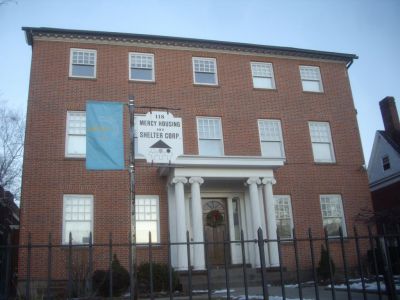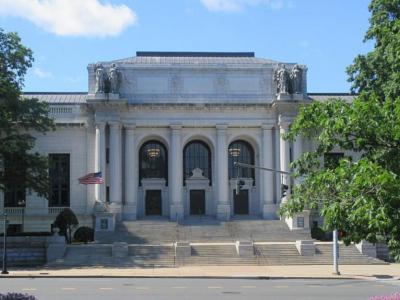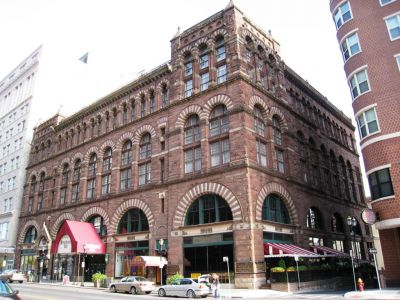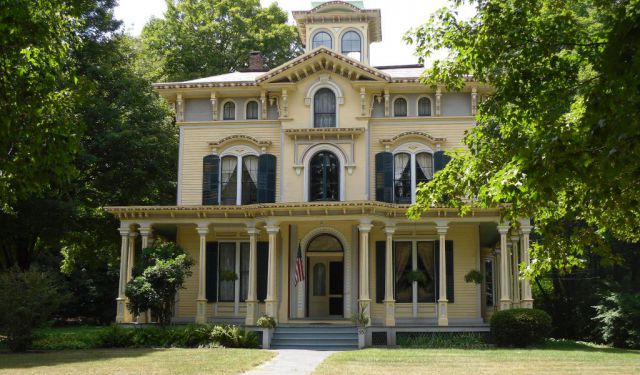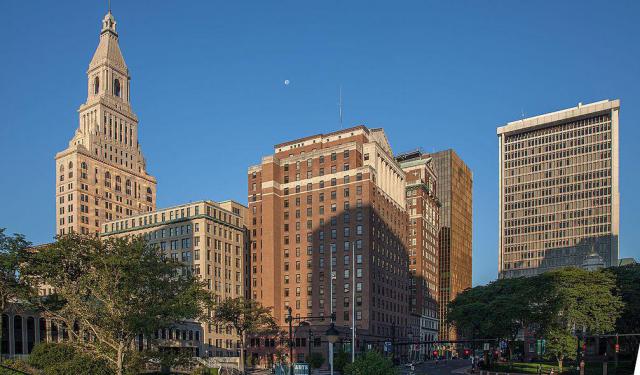
Architectural Jewels (Self Guided), Hartford
Hartford, Connecticut abounds in one-of-a-kind, artistically unique structures – homes, museums, libraries, and government halls – each with a distinctive look, appeal, and history of their own. Some of them are celebrated works by well-known architects, and display a variety of styles.
Among these jewels is Armsmear, a historic mansion originally built for Samuel Colt, the famed inventor and industrialist in the second half of the 19th century. Its grandiose Italian villa architecture and opulent interiors showcase the wealth and sophistication of the era.
The Henry Barnard House stands as a testament to Georgian-era elegance. Named after Henry Barnard, a pioneering educator, this charming residence now functions as a homeless shelter under the ownership of a religious charity, offering a glimpse into the refined lifestyle of the past.
Temple Beth Israel, with its striking Romanesque Revival architecture, is a symbol of religious diversity and architectural innovation in Hartford. The city's oldest purpose-built synagogue, it has been rescued from demolition and today represents a vital preservation of local Jewish heritage.
Connecticut's State Library and the Connecticut State Capitol are architectural marvels that embody the state's commitment to knowledge and governance. The State Library's neoclassical design exudes a sense of grandeur, while the Capitol building's imposing dome and majestic façade command attention and reverence.
The Old State House, a historic landmark dating back to the late 18th century, is a gem of Federal architecture. Its iconic red brick exterior and stately columns serve as a reminder of Hartford's role in shaping the nation's history.
The Cheney Building, with its elegant Richardsonian style, represents Hartford's industrial heritage and entrepreneurial spirit. This historic commercial building features distinctive architectural elements reflecting the air of the 1870s.
To truly appreciate Hartford's architectural jewels, one must explore them firsthand. This self-guided tour is equally suited for a history enthusiast, an admirer of fine craftsmanship, or simply anyone seeking inspiration. So, go for it and immerse yourself in the beauty of Hartford's architectural landmarks!
Among these jewels is Armsmear, a historic mansion originally built for Samuel Colt, the famed inventor and industrialist in the second half of the 19th century. Its grandiose Italian villa architecture and opulent interiors showcase the wealth and sophistication of the era.
The Henry Barnard House stands as a testament to Georgian-era elegance. Named after Henry Barnard, a pioneering educator, this charming residence now functions as a homeless shelter under the ownership of a religious charity, offering a glimpse into the refined lifestyle of the past.
Temple Beth Israel, with its striking Romanesque Revival architecture, is a symbol of religious diversity and architectural innovation in Hartford. The city's oldest purpose-built synagogue, it has been rescued from demolition and today represents a vital preservation of local Jewish heritage.
Connecticut's State Library and the Connecticut State Capitol are architectural marvels that embody the state's commitment to knowledge and governance. The State Library's neoclassical design exudes a sense of grandeur, while the Capitol building's imposing dome and majestic façade command attention and reverence.
The Old State House, a historic landmark dating back to the late 18th century, is a gem of Federal architecture. Its iconic red brick exterior and stately columns serve as a reminder of Hartford's role in shaping the nation's history.
The Cheney Building, with its elegant Richardsonian style, represents Hartford's industrial heritage and entrepreneurial spirit. This historic commercial building features distinctive architectural elements reflecting the air of the 1870s.
To truly appreciate Hartford's architectural jewels, one must explore them firsthand. This self-guided tour is equally suited for a history enthusiast, an admirer of fine craftsmanship, or simply anyone seeking inspiration. So, go for it and immerse yourself in the beauty of Hartford's architectural landmarks!
How it works: Download the app "GPSmyCity: Walks in 1K+ Cities" from Apple App Store or Google Play Store to your mobile phone or tablet. The app turns your mobile device into a personal tour guide and its built-in GPS navigation functions guide you from one tour stop to next. The app works offline, so no data plan is needed when traveling abroad.
Architectural Jewels Map
Guide Name: Architectural Jewels
Guide Location: USA » Hartford (See other walking tours in Hartford)
Guide Type: Self-guided Walking Tour (Sightseeing)
# of Attractions: 7
Tour Duration: 2 Hour(s)
Travel Distance: 3.1 Km or 1.9 Miles
Author: Dee
Sight(s) Featured in This Guide:
Guide Location: USA » Hartford (See other walking tours in Hartford)
Guide Type: Self-guided Walking Tour (Sightseeing)
# of Attractions: 7
Tour Duration: 2 Hour(s)
Travel Distance: 3.1 Km or 1.9 Miles
Author: Dee
Sight(s) Featured in This Guide:
- Armsmear
- Henry Barnard House
- Temple Beth Israel
- Connecticut’s State Library
- Connecticut State Capitol
- Old State House
- Cheney Building
1) Armsmear
Armsmear ("meadow of arms"), also known as the Samuel Colt Home, is a historic house in Hartford, Connecticut. It was the family home of firearm manufacturer Samuel Colt. Armsmear was listed as a National Historic Landmark in 1976; this designation was expanded in 2008 to form the Coltsville Historic District, a National Historic Landmark District.
Armsmear was planned for Colt's 1856 marriage to Elizabeth Hart Jarvis, and constructed in 1856 on grounds overlooking the recently completed Colt Armory. It was described by a contemporary thus: "an Italian villa in stone, massive, noble, refined, yet not carrying out any decided principle of architecture, it is like its originator, bold and unusual in its combinations." It features a low-pitched roof, heavy bracketed cornice, round-arched doors and windows, iron balconies, Italianate tower and details, and Turkish domes and pinnacles.
The Colts occupied Armsmear in 1857 and promptly began to develop its gardens. Unusual, glass-domed conservatories, inspired by London's Crystal Palace, were added in 1861-1862. Ultimately the estate contained greenhouses, as well as ponds, fountains, and a deer park.
The house and manicured grounds were the primary residence of Samuel Colt and his family. The Colts entertained lavishly at the estate, holding large parties that were the highlight of the Hartford society season. Samuel Colt lived in Armsmear for approximately 5 years from 1857 until his death in 1862. He was buried on the grounds of Armsmear near the graves of Sam and Elizabeth's young children, amidst a copse of weeping willows known as the 'Grove of Graves.' Following her husband's death, Elizabeth Hart Colt and her son Caldwell Hart Colt lived together in the large home for several decades.
After Elizabeth Colt died in 1905, the house was converted to a home for Episcopal women (in 1911) under the terms of her will. The residential community to this day is administrated by the Colt Trust. She also gave 140 acres (57 ha) of Armsmear's grounds to create Hartford's Colt Park. The city has subsequently replaced the greenhouse, garden, and ponds with ball fields and a skating rink.
Armsmear was planned for Colt's 1856 marriage to Elizabeth Hart Jarvis, and constructed in 1856 on grounds overlooking the recently completed Colt Armory. It was described by a contemporary thus: "an Italian villa in stone, massive, noble, refined, yet not carrying out any decided principle of architecture, it is like its originator, bold and unusual in its combinations." It features a low-pitched roof, heavy bracketed cornice, round-arched doors and windows, iron balconies, Italianate tower and details, and Turkish domes and pinnacles.
The Colts occupied Armsmear in 1857 and promptly began to develop its gardens. Unusual, glass-domed conservatories, inspired by London's Crystal Palace, were added in 1861-1862. Ultimately the estate contained greenhouses, as well as ponds, fountains, and a deer park.
The house and manicured grounds were the primary residence of Samuel Colt and his family. The Colts entertained lavishly at the estate, holding large parties that were the highlight of the Hartford society season. Samuel Colt lived in Armsmear for approximately 5 years from 1857 until his death in 1862. He was buried on the grounds of Armsmear near the graves of Sam and Elizabeth's young children, amidst a copse of weeping willows known as the 'Grove of Graves.' Following her husband's death, Elizabeth Hart Colt and her son Caldwell Hart Colt lived together in the large home for several decades.
After Elizabeth Colt died in 1905, the house was converted to a home for Episcopal women (in 1911) under the terms of her will. The residential community to this day is administrated by the Colt Trust. She also gave 140 acres (57 ha) of Armsmear's grounds to create Hartford's Colt Park. The city has subsequently replaced the greenhouse, garden, and ponds with ball fields and a skating rink.
Sight description based on Wikipedia.
2) Henry Barnard House
The Henry Barnard House is a historic house and National Historic Landmark in Hartford, Connecticut. It was the lifelong home of educator Henry Barnard (1811–1900), an education reformer who was instrumental (along with Horace Mann) in the development of the American public school system. Barnard established the statewide education systems of both Connecticut and Rhode Island, which served as models for the development of such infrastructure in other states. The house is now owned by a religious charity, which operates a homeless shelter on the premises.
The Barnard House is a three-story brick structure, five bays wide and three deep, with a side gable roof. The entrance is centered on the front facade, and is sheltered by a portico supported by paired fluted Ionic columns. The entrance is flanked by sidelight windows and pilasters, and topped by a semi-circular four leaf transom window and an entablature. The only other significant exterior styling is the modillioned cornice below the roof line. The interior of the house has been somewhat altered due to its later institutional use, but has retained a basic center hall plan with parlors on either side. The most significant alteration has been the addition of two large sections to the back of the house, which nearly triple its size. These are used to provide shelter space for the local homeless population.
The house was built in 1807, and it was four years later that Henry Barnard was born here. At the time it was located in a fashionable neighborhood of the city, and originally included more land than it presently does. The house remained in the Barnard family until his death in 1900, when it was acquired by the Sisters of Mercy, who operate services for the homeless. It was declared a National Historic Landmark in 1965.
Henry Barnard was educated at Yale College, trained as a lawyer, and entered politics, winning election to the Connecticut state legislature in 1837. Barnard had studied education systems in Europe during travels there, and promoted legislation for statewide supervision of public education. He was thereafter appointed the state's first secretary of education. Forced out of that post by political opponents, he was given a similar post in neighboring Rhode Island, where he promoted legislation creating the nation's first normal school (teacher's college), passed in 1845. He then returned to Connecticut, where he became superintendent of schools, and oversaw establishment of its normal school. He later served in education-related posts in Wisconsin, Maryland, and was the first United States Commissioner of Education, appointed in 1867. He died in this house in 1900.
The Barnard House is a three-story brick structure, five bays wide and three deep, with a side gable roof. The entrance is centered on the front facade, and is sheltered by a portico supported by paired fluted Ionic columns. The entrance is flanked by sidelight windows and pilasters, and topped by a semi-circular four leaf transom window and an entablature. The only other significant exterior styling is the modillioned cornice below the roof line. The interior of the house has been somewhat altered due to its later institutional use, but has retained a basic center hall plan with parlors on either side. The most significant alteration has been the addition of two large sections to the back of the house, which nearly triple its size. These are used to provide shelter space for the local homeless population.
The house was built in 1807, and it was four years later that Henry Barnard was born here. At the time it was located in a fashionable neighborhood of the city, and originally included more land than it presently does. The house remained in the Barnard family until his death in 1900, when it was acquired by the Sisters of Mercy, who operate services for the homeless. It was declared a National Historic Landmark in 1965.
Henry Barnard was educated at Yale College, trained as a lawyer, and entered politics, winning election to the Connecticut state legislature in 1837. Barnard had studied education systems in Europe during travels there, and promoted legislation for statewide supervision of public education. He was thereafter appointed the state's first secretary of education. Forced out of that post by political opponents, he was given a similar post in neighboring Rhode Island, where he promoted legislation creating the nation's first normal school (teacher's college), passed in 1845. He then returned to Connecticut, where he became superintendent of schools, and oversaw establishment of its normal school. He later served in education-related posts in Wisconsin, Maryland, and was the first United States Commissioner of Education, appointed in 1867. He died in this house in 1900.
Sight description based on Wikipedia.
3) Temple Beth Israel
Temple Beth Israel is a historic Jewish synagogue building in Hartford, Connecticut. Built in 1875-76, it is the oldest purpose-built synagogue building in the state. The building was listed on the National Register of Historic Places in 1978. After being rescued from threatened demolition, it now houses a local cultural center. The congregation, established in 1843, is now located at a synagogue in West Hartford.
The Temple Beth Israel building is located south of downtown Hartford in the Sheldon-Charter Oak neighborhood. It is on the south side of Charter Oak Avenue, just east its junction with Main Street and west of Charter Oak Park. It is a 2-1/2 story brick structure with a brownstone foundation and stone trim. It has a gabled roof, flanked at the front by towers with octagonal domed tops. Windows and entrances are set in round-arch openings in the Romanesque style.
The synagogue was designed by George Keller and built in 1875-76 for a Jewish congregation established in 1843. It was in 1843 that the state, at the instigation of the congregation's leadership, passed a law making it possible for Jewish congregations to build synagogues. It is the only known High Victorian Romanesque work of Keller, who was one of Hartford's leading architects of the second half of the 20th century. The temple was used by that congregation until 1935, when it was sold to the Calvary Temple congregation, which occupied it until 1974. After standing vacant for some years, the city threatened to demolish it. Jewish groups around the state organized to preserve it, and it now houses the Charter Oak Cultural Center.
The Temple Beth Israel building is located south of downtown Hartford in the Sheldon-Charter Oak neighborhood. It is on the south side of Charter Oak Avenue, just east its junction with Main Street and west of Charter Oak Park. It is a 2-1/2 story brick structure with a brownstone foundation and stone trim. It has a gabled roof, flanked at the front by towers with octagonal domed tops. Windows and entrances are set in round-arch openings in the Romanesque style.
The synagogue was designed by George Keller and built in 1875-76 for a Jewish congregation established in 1843. It was in 1843 that the state, at the instigation of the congregation's leadership, passed a law making it possible for Jewish congregations to build synagogues. It is the only known High Victorian Romanesque work of Keller, who was one of Hartford's leading architects of the second half of the 20th century. The temple was used by that congregation until 1935, when it was sold to the Calvary Temple congregation, which occupied it until 1974. After standing vacant for some years, the city threatened to demolish it. Jewish groups around the state organized to preserve it, and it now houses the Charter Oak Cultural Center.
Sight description based on Wikipedia.
4) Connecticut’s State Library
Connecticut’s State Library and Supreme Court Building includes the Library, State Archives, and Museum of Connecticut History. The groundbreaking ceremony for the Connecticut State Library and Supreme Court Building was held on July 29, 1908. Architects Donn Barber of New York and E. T. Hapgood of Hartford envisioned a design based on an adaptation of the Italian Renaissance style of architecture. The design includes three wings off a central lobby, the State Library on the left, Memorial Hall in the center and the Supreme Court on the right. Construction began on October 23, 1908. On November 28, 1910, State Librarian George Godard and his staff moved into the new building.
The library building was listed on the National Register of Historic Places in 1981, recognizing both its architecture and its significance as a repository of state history.
The library building was listed on the National Register of Historic Places in 1981, recognizing both its architecture and its significance as a repository of state history.
Sight description based on Wikipedia.
5) Connecticut State Capitol (must see)
The 20 foot tall dome of the Connecticut State Capitol is a sight to behold. Visitors are welcome to take self-guided tours or enjoy a tour led by one of the experts who are well versed in the history and architecture of this magnificent building.
Self-guided tours may be conducted at any time that the building is open. Those large groups wanting a guided tour should contact the Capitol in advance to arrange a time. Groups of up to 30 people can attend each tour. Smaller groups can arrive at the visitor desk and request to join a tour, but this is not guaranteed.
The capitol, located in Bushnell Park, dates to 1878. It contains a number of elaborate stained glass windows, sculptures and statues. It is a working building. Therefore, visitors are asked to remain quiet while admiring the building and its many fascinating features.
A statue that visitors must see is the Genius of Connecticut. This bronze and plaster statue was crafted in 1878 by Randolph Rogers. She is said to symbolize the spirit of the people of Connecticut.
The Hall of Flags, in the west wing of the Capitol, holds historic state flags and battle flags from the Civil War. The Hall of Flags is also home to a statue of William A. Buckingham, who was the governor of the state during the Civil War.
Other artifacts to look for at the Capitol are the bed that formerly belonged to the Marquis de Lafayette, the tombstone of Israel Punam and the Hotchkiss Revolving Cannon.
Why You Should Visit:
The Capitol allows visitors a unique perspective into the state. They can see the history of Connecticut while also experiencing present-day governing. Guided tours may be worth the extra effort as they can take visitors to places they might not otherwise reach.
Visiting the State Capitol is both educational and economical. Entry into the building and the tours are free.
Tips:
Take time to look around while exploring the Capitol. There are important and interesting details hiding in the rugs, wall hangings and even the ceiling.
Food and drink is not allowed while touring the Capitol, but visitors can purchase meals at the on-site cafeteria. There is also a small gift shop on the first floor.
Self-guided tours may be conducted at any time that the building is open. Those large groups wanting a guided tour should contact the Capitol in advance to arrange a time. Groups of up to 30 people can attend each tour. Smaller groups can arrive at the visitor desk and request to join a tour, but this is not guaranteed.
The capitol, located in Bushnell Park, dates to 1878. It contains a number of elaborate stained glass windows, sculptures and statues. It is a working building. Therefore, visitors are asked to remain quiet while admiring the building and its many fascinating features.
A statue that visitors must see is the Genius of Connecticut. This bronze and plaster statue was crafted in 1878 by Randolph Rogers. She is said to symbolize the spirit of the people of Connecticut.
The Hall of Flags, in the west wing of the Capitol, holds historic state flags and battle flags from the Civil War. The Hall of Flags is also home to a statue of William A. Buckingham, who was the governor of the state during the Civil War.
Other artifacts to look for at the Capitol are the bed that formerly belonged to the Marquis de Lafayette, the tombstone of Israel Punam and the Hotchkiss Revolving Cannon.
Why You Should Visit:
The Capitol allows visitors a unique perspective into the state. They can see the history of Connecticut while also experiencing present-day governing. Guided tours may be worth the extra effort as they can take visitors to places they might not otherwise reach.
Visiting the State Capitol is both educational and economical. Entry into the building and the tours are free.
Tips:
Take time to look around while exploring the Capitol. There are important and interesting details hiding in the rugs, wall hangings and even the ceiling.
Food and drink is not allowed while touring the Capitol, but visitors can purchase meals at the on-site cafeteria. There is also a small gift shop on the first floor.
6) Old State House (must see)
Connecticut's Old State House is a downtown building that is a marriage of yesterday and today. The Old State House was completed in 1796 where it was used for government affairs. Over the years it has served a number of different purposes, including as a site for conventions, trials, museums and, currently, a popular farmer's market. In 1839, the start of the Amistad trial was held there.
The Old State House has a reputation for being haunted, which makes it a must-see for those who enjoy all things macabre. It has even appeared on an episode of the paranormal investigation show "Ghost Hunters."
In addition to its haunted history, the third floor of the Old State House is home to the Joseph Steward Museum of Curiosities. Joseph Steward began collecting these curiosities in the late 18th century and added to them throughout his life. Some of the items include a calf with two heads, a pig with two heads, over-sized animals and machinery with unknown uses.
The Farmers Market is the oldest of its kind in the state. Those who are lucky enough to be visiting on a Tuesday or Friday can attend the open air market where they will find farmers, artisans and even manufactured goods. A holiday shopping fair is also held at the state house during the holiday season.
Tours can be self-guided or led by volunteers. The Old State House features hands-on activities that can be enjoyed by all members of the family. Fun historic items, like Mark Twain's bicycle, are offered here as well.
Why You Should Visit:
Connecticut's Old State House has something for everyone. The low cost of admission and the wide number of activities make the Old State House a must-see.
Tips:
Cost to visit the Old State House is $8 for adults, $4 for students and children under the age of five are free. Those planning to visit Connecticut's Old State House should call first to make sure the building is open.
The Old State House has a reputation for being haunted, which makes it a must-see for those who enjoy all things macabre. It has even appeared on an episode of the paranormal investigation show "Ghost Hunters."
In addition to its haunted history, the third floor of the Old State House is home to the Joseph Steward Museum of Curiosities. Joseph Steward began collecting these curiosities in the late 18th century and added to them throughout his life. Some of the items include a calf with two heads, a pig with two heads, over-sized animals and machinery with unknown uses.
The Farmers Market is the oldest of its kind in the state. Those who are lucky enough to be visiting on a Tuesday or Friday can attend the open air market where they will find farmers, artisans and even manufactured goods. A holiday shopping fair is also held at the state house during the holiday season.
Tours can be self-guided or led by volunteers. The Old State House features hands-on activities that can be enjoyed by all members of the family. Fun historic items, like Mark Twain's bicycle, are offered here as well.
Why You Should Visit:
Connecticut's Old State House has something for everyone. The low cost of admission and the wide number of activities make the Old State House a must-see.
Tips:
Cost to visit the Old State House is $8 for adults, $4 for students and children under the age of five are free. Those planning to visit Connecticut's Old State House should call first to make sure the building is open.
7) Cheney Building
The R. and F. Cheney Building, also known as the Brown Thomson Building, is a commercial building designed by noted American architect H. H. Richardson. It is located on Main Street in Hartford, Connecticut, and is now on the National Register of Historic Places.
The Cheney Building was constructed 1875–1876 for the Cheney Brothers silk manufacturers in Manchester, Connecticut. It was originally a multipurpose structure with five small shops on the ground floor, and offices and apartments above. For many years it housed Brown Thomson's department store, and later the G. Fox and Company.
The building dominates its corner location with its facade organized into three heavy, horizontal tiers of roughly cut, reddish brownstone punctuated with much lighter Berea limestone trim. The lowest tier is defined by a series of huge round arches in striking polychrome bands, a motif repeated in the stories above at an increasingly smaller scale. The ground-floor tier on the Main Street facade features five broad arches above shop windows and doors. The second floor tier features two-story arcade of 10 major openings, while the third floor tier features single-story arcade of 14 openings.
The building is crowned with low, asymmetric towers at its Main Street corners. As of 2007, it has been renamed as the Richardson Building, and now hosts a Residence Inn by Marriott, and several offices, stores, and restaurants.
The Cheney Building was constructed 1875–1876 for the Cheney Brothers silk manufacturers in Manchester, Connecticut. It was originally a multipurpose structure with five small shops on the ground floor, and offices and apartments above. For many years it housed Brown Thomson's department store, and later the G. Fox and Company.
The building dominates its corner location with its facade organized into three heavy, horizontal tiers of roughly cut, reddish brownstone punctuated with much lighter Berea limestone trim. The lowest tier is defined by a series of huge round arches in striking polychrome bands, a motif repeated in the stories above at an increasingly smaller scale. The ground-floor tier on the Main Street facade features five broad arches above shop windows and doors. The second floor tier features two-story arcade of 10 major openings, while the third floor tier features single-story arcade of 14 openings.
The building is crowned with low, asymmetric towers at its Main Street corners. As of 2007, it has been renamed as the Richardson Building, and now hosts a Residence Inn by Marriott, and several offices, stores, and restaurants.
Sight description based on Wikipedia.
Walking Tours in Hartford, Connecticut
Create Your Own Walk in Hartford
Creating your own self-guided walk in Hartford is easy and fun. Choose the city attractions that you want to see and a walk route map will be created just for you. You can even set your hotel as the start point of the walk.
Hartford's Historical Houses Tour
Visiting old houses is like treasure hunting, where you are bound to uncover secrets of the former owners. Hartford was once home to well-known historic figures, whose abodes today have been converted into museums for future generations to explore.
Among these is the Mark Twain House, a former residence of the iconic American author Samuel Clemens, better known as Mark Twain. This Victorian... view more
Tour Duration: 2 Hour(s)
Travel Distance: 3.6 Km or 2.2 Miles
Among these is the Mark Twain House, a former residence of the iconic American author Samuel Clemens, better known as Mark Twain. This Victorian... view more
Tour Duration: 2 Hour(s)
Travel Distance: 3.6 Km or 2.2 Miles
Hartford Introduction Walking Tour
Hartford, Connecticut is one of the oldest cities in the United States. Founded in 1635, this capital city of Connecticut has a long and storied history. The city offers a multitude of museums, a booming art scene, interesting architecture and excellence in cuisine.
The area where Hartford now sits was once home to Algonquins. More specifically, it was inhabited by the Massacoes, Podunks,... view more
Tour Duration: 1 Hour(s)
Travel Distance: 2.1 Km or 1.3 Miles
The area where Hartford now sits was once home to Algonquins. More specifically, it was inhabited by the Massacoes, Podunks,... view more
Tour Duration: 1 Hour(s)
Travel Distance: 2.1 Km or 1.3 Miles
The Most Popular Cities
/ view all

